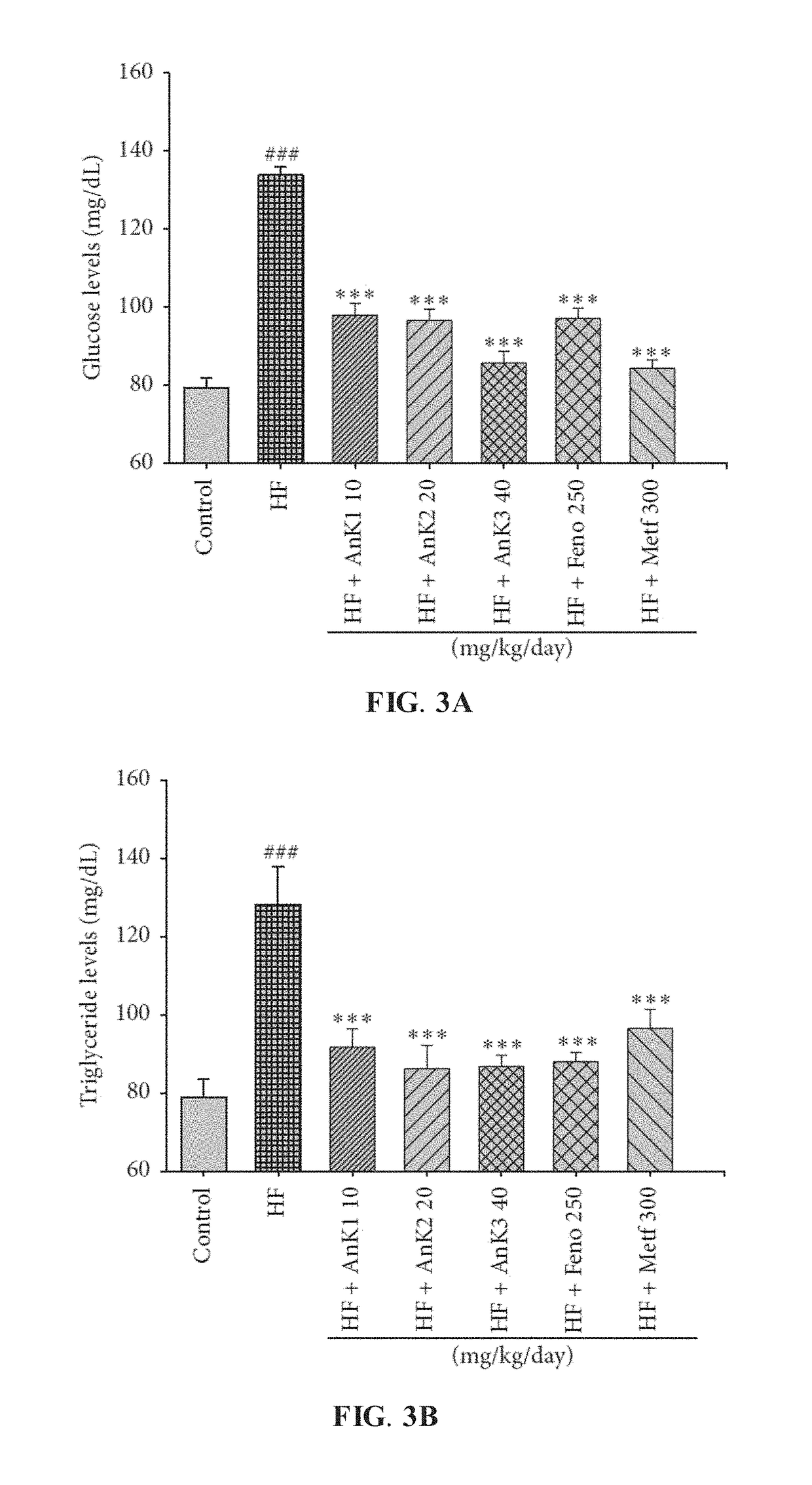Method for treatment of hyperglycemia and hyperlipidemia
a hyperlipidemia and hyperglycemia technology, applied in the field of hyperlipidemia and hyperglycemia, can solve the problems of lactic acidosis side effects, rare and expensive, diarrhea, nausea, vomiting, etc., and achieve the effects of improving dyslipidemia, enhancing glut4 and phospho-ampk expression, and reducing the risk of lactic acidosis
- Summary
- Abstract
- Description
- Claims
- Application Information
AI Technical Summary
Benefits of technology
Problems solved by technology
Method used
Image
Examples
example 1
AnK Enhances Expression Levels of Membrane GLUT4 and Akt Phosphorylation
[0065]To evaluate the antidiabetic potential of AnK, C2C12 myoblast cells without treatment (the control group) or treated with insulin, DMSO, or various amounts of AnK were examined for expression levels of membrane GLUT4, phospho-Akt (Ser473) / total-Akt, and phospho-AMPK (Thr172) / total-AMPK.
[0066]As shown in FIGS. 2A-2B, when compared with the control group (denoted as CON in FIGS. 2A-2B), C2C12 cells treated with insulin (100 nM) and AnK (1, 5, 10 and 25 μg / mL) exhibited enhanced protein expressions of membrane GLUT4. The expression ratios of phospho-Akt (p-Akt) to total-Akt (t-Akt) and phospho-AMPK (p-AMPK) to total-AMPK (t-AMPK) were higher in the insulin-treated and AnK-treated cells than in CON group. In FIG. 2B, all values are means±SE; *** P<0.001 was compared with the CON group. Furthermore, treatment of AnK (between 1 and 25 μg / mL) was found to be non-toxic to C2C12 cells in the MTT (3-[4,5-dimethylthi...
example 2
2.1 AnK Reduces Body Weight Gain and Weights of Adipose Tissue
[0067]To verify the antidiabetic and antihyperlipidemic effects of AnK, mice fed on HFD for 8 weeks were administered with distilled water, metformin (Metf), fenofibrate (Feno), or various amounts of AnK as previously described and fed on HFD for additional 4 weeks.
[0068]Body weight and weights of adipose tissue for the HF group, which was administered with distilled water, and the AnK-treated HFD groups were first examined. At the beginning, the average body weight of all mice was 20.05±0.13 g. At the end of the experiment, as shown in TABLE 2, body weight and body weight gain were markedly enhanced in the HF group than in the CON group. Compared with the HF group, the HF+AnK2, HF+AnK3, and HF+Feno groups exhibited decreased final body weight, and the HF+AnK1, HF+AnK2, HF+AnK3, HF+Feno, and HF+Metf groups exhibited decreased body weight gain. Furthermore, the HF group consumed less food than the CON group, and no differe...
example 3
Inhibition of Adipocyte Hypertrophy and Hepatocellular Ballooning
[0077]Adipocyte hypertrophy, the pathological enlargement of adipocytes, is often found in subjects with type 2 diabetes and hyperlipidemia. To verify the therapeutic effect of AnK on adipocyte hypertrophy, morphology of the epididymal white adipose tissue from mice of the HF group and the AnK-treated HFD groups was examined. Micrographs (magnification 200X) of the EWAT sections for each group were shown in FIG. 4 and analyzed to determine the mean area of an epididymal adipocyte.
[0078]According to FIG. 4A, adipocyte hypertrophy was observed in the HF group in comparison to the CON group. The mean areas of the adipocytes in the HF group and the CON group were 10142.9±428.1 μm2 and 6044.4±359.1 μm2, respectively. As shown in TABLE 3, treatment with AnK1, AnK2, AnK3, Feno, or Metf resulted in less adipocyte hypertrophy. These data indicate that AnK inhibits adipocyte hypertrophy and lipid accumulation.
[0079]
TABLE 3Effect...
PUM
 Login to View More
Login to View More Abstract
Description
Claims
Application Information
 Login to View More
Login to View More - R&D
- Intellectual Property
- Life Sciences
- Materials
- Tech Scout
- Unparalleled Data Quality
- Higher Quality Content
- 60% Fewer Hallucinations
Browse by: Latest US Patents, China's latest patents, Technical Efficacy Thesaurus, Application Domain, Technology Topic, Popular Technical Reports.
© 2025 PatSnap. All rights reserved.Legal|Privacy policy|Modern Slavery Act Transparency Statement|Sitemap|About US| Contact US: help@patsnap.com



